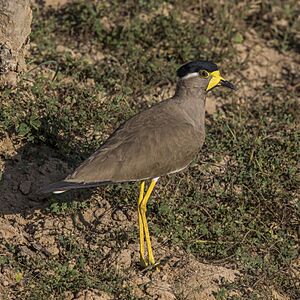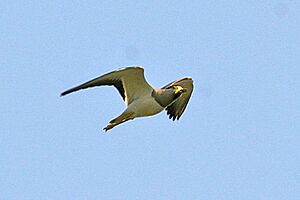Yellow-wattled lapwing facts for kids
Quick facts for kids Yellow-wattled lapwing |
|
|---|---|
 |
|
| in Yala National Park, Sri Lanka |
|
| Conservation status | |
| Scientific classification | |
| Genus: |
Vanellus
|
| Species: |
malabaricus
|
| Synonyms | |
|
Charadrius malabaricus |
|
The yellow-wattled lapwing (Vanellus malabaricus) is a type of lapwing bird. It is only found in the Indian Subcontinent. These birds live mainly on the dry plains of India. They have a loud call and can fly very fast. Even though they do not migrate long distances, they do move around depending on the rainy season.
Yellow-wattled lapwings are dull grey-brown with a black cap on their head. They have bright yellow legs and a yellow, triangle-shaped wattle near their beak. Like other lapwings, they are ground birds. Their nest is just a few tiny pebbles where they lay their well-hidden eggs. Their chicks are called 'nidifugous'. This means they leave the nest very soon after hatching. They follow their parents to find food.
Contents
About the Yellow-Wattled Lapwing
These birds are easy to spot. They live in dry, rocky, and open grasslands or scrub areas. They are medium-sized birds with pale brown feathers. They have a black crown on their head. A thin white band separates the crown from the brown neck. They also have large yellow wattles on their face.
Their chin and throat are black. The brown neck and upper chest are separated from the white belly by a thin black line. Their tail has a black band near the end. This band does not reach the outer tail feathers. They also have a white bar on the inner part of their wing. The beak is yellow at the bottom. They have small yellow spurs on their wings. These birds can raise their crown feathers slightly when they are showing off.
Yellow-wattled lapwings usually stay in one place. However, some groups move long distances when the monsoons arrive. They sometimes visit the Kathmandu valley in Nepal. One bird was even seen in Malaysia.
There are no different types (subspecies) of this bird. But, birds from the south are smaller than those from the north. They are about 26 to 28 centimeters long. Their wings are about 19 to 21 centimeters long. Their beak is about 2.3 to 2.6 centimeters long. Their legs are about 5.7 to 6.6 centimeters long. Their tail is about 7.1 to 8.4 centimeters long. Young birds have a brown crown. Male and female birds look similar. However, males have slightly longer wings and legs. Their call is a sharp tchee-it.
These birds have different names in local languages. For example, they are called zirdi in Hindi. In Telugu, they are known as chitawa. In Tamil, they are called aalkati.
Where Yellow-Wattled Lapwings Live
This bird is common in many parts of India. It can be seen in various open lowland areas. It prefers drier places than the red-wattled lapwing, Vanellus indicus. You can find them in most parts of India. They also live in parts of Pakistan, Nepal, Bangladesh, and Sri Lanka. They move short distances when it rains. However, we do not know the exact pattern of these movements.
Yellow-Wattled Lapwing Life Cycle
These lapwings lay eggs during the dry season. Most eggs are laid from March to May, before the monsoons start. Their nesting area is about 2.7 acres. They lay four eggs in a small dip on the ground. It is rare to find a nest in a clump of grass.
Parents will visit water and soak their chest feathers. They might stay for up to 10 minutes to soak water. They then use these wet feathers to cool their eggs or chicks. The four eggs usually hatch at the same time. This happens even though they are laid a few days apart. The young chicks are hard to see. They find food with their parents. When parents make an alarm call, the chicks squat flat on the ground and stay still.
Sometimes, a second group of eggs is laid. This often happens if the first group fails. Young birds from a previous group have been seen with parents incubating new eggs. Several pairs of birds have been seen doing courtship displays close to each other. One study found that over 60% of nests had four eggs. The rest had three eggs. About 27.58% of the eggs hatched. Eggs were lost due to predators and nest damage. The eggs took 27 to 30 days to hatch. When someone comes near the nest, the bird sitting on the eggs tries to move away without drawing attention to the nest.
Yellow-wattled lapwings eat beetles, termites, and other small creatures. They pick these from the ground. A type of feather mite called Magimelia dolichosikya has been found on these birds.
Images for kids








